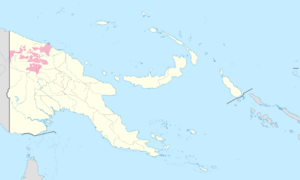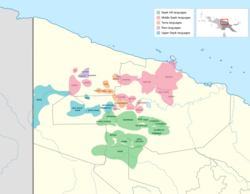Sepik languages
Topic: Social
 From HandWiki - Reading time: 7 min
From HandWiki - Reading time: 7 min
| Sepik | |
|---|---|
| Sepik River | |
| Geographic distribution | Sepik River region, northern Papua New Guinea (mostly in East Sepik Province) |
| Linguistic classification | One of the world's primary language families |
| Subdivisions |
|
| Glottolog | sepi1257[1] |
 Distribution of Sepik languages in Papua New Guinea | |
The Sepik or Sepik River languages are a family of some 50 Papuan languages spoken in the Sepik river basin of northern Papua New Guinea, proposed by Donald Laycock in 1965 in a somewhat more limited form than presented here. They tend to have simple phonologies, with few consonants or vowels and usually no tones.
The best known Sepik language is Iatmul. The most populous are Iatmul's fellow Ndu languages Abelam and Boiken, with about 35,000 speakers each.
The Sepik languages, like their Ramu neighbors, appear to have three-vowel systems, /ɨ ə a/, that distinguish only vowel height in a vertical vowel system. Phonetic [i e o u] are a result of palatal and labial assimilation to adjacent consonants. It is suspected that the Ndu languages may reduce this to a two-vowel system, with /ɨ/ epenthetic (Foley 1986).
Classification
The Sepik languages consist of two branches of Kandru's Laycock's Sepik–Ramu proposal, the Sepik subphylum and Leonhard Schultze stock. According to Malcolm Ross, the most promising external relationship is not with Ramu, pace Laycock, but with the Torricelli family.
Palmer (2018) classifies the Leonhard Schultze languages as an independent language phylum.[2]
Usher (2020)
In the cladogram below,[3] the small, closely related families in bold at the ends of the branches are covered in separate articles.
| Sepik |
| |||||||||||||||||||||||||||||||||||||||||||||||||||||||||||||||||||||
Foley (2018)
Foley (2018) provides the following classification, with 6 main branches recognized.[4]
- Sepik family
- Middle Sepik languages
- Ndu languages
- Nukuma languages
- Yerakai (Garamambu)
- Yellow River languages
- Tama languages
- Sepik Hill languages
- Eastern (Alamblak)
- Central (Bahinemo)
- Western: Saniyo-Hiyewe, Paka (Setiali), Gabiano (Niksek), Piame, Bikaru, Umairof, Hewa
- Ram languages
- Upper Sepik languages
- Wogamus languages
- Iwam languages
- Abau
- Amal
- Middle Sepik languages
Like the neighboring Torricelli languages, but unlike the rest of the Sepik languages, the Ram and Yellow River languages do not have clause chaining constructions (for an example of a clause chaining construction in a Trans-New Guinea language, see Kamano language#Clause chaining). Foley (2018) suggests that many of the Ram and Yellow River-speaking peoples may have in fact been Torricelli speakers who were later assimilated by Sepik-speaking peoples.[4]:298
Foley classifies the Leonhard Schultze languages separately as an independent language family.[4]
Pronouns
The pronouns Ross reconstructs for proto-Sepik are:[5]
I *wan we two *na-nd, *na-p we *na-m thou (M) *mɨ-n you two *kwə-p you *kwə-m thou (F) *yɨ-n, *nyɨ-n he *ətə-d, *də they two *ətə-p, *tɨ-p they *ətə-m, *tɨ-m she *ətə-t, *tɨ
Note the similarities of the dual and plural suffixes with those of the Torricelli languages.
Ross reconstructs two sets of pronouns for "proto–Upper Sepik" (actually, Abau–Iwam and Wogamusin (Tama)). These are the default set (Set I), and a set with "certain interpersonal and pragmatic functions" (table 1.27):
Pronoun Set I I *an we two *nə-d we *nə-n thou (M) *nɨ you two *nə-p you *nə-m thou (F) (*nɨ-n) he *tə- they two (*rə-p) they *ra-m she *tɨ-
Pronoun Set II I *ka we two *krə-d we *krə-m thou (M) *kɨ you two *kə-p you *kə-m thou (F) ? he *si they two *sə-p they (*sə-m) she (*sae)
Most Sepik languages have reflexes of proto-Sepik *na ~ *an for 1sg, *no for 1pl, and *ni for 2sg.[4]
Cognates
Proto-Sepik forms reconstructed by Foley (2018) that are widespread across the family:[4]
gloss proto-Sepik ‘breast’ *muk ‘tongue’ *ta(w)r ‘tree’ *mi ‘dog’ *wara ‘louse’ *nim ‘feces’ *ri ‘go’ *(y)i ‘come’ *ya ‘1sg’ *na ~ *an ‘2sg’ *ni ‘1pl’ *no ‘dative suffix’ *-ni ‘locative suffix’ *-kV
Typological overview
Even internally within Sepik subgroups, languages in the Sepik family can have vastly different typological profiles varying from isolating to agglutinative, with example languages listed below.[4]
group isolating agglutinative Ndu Ambulas Manambu Sepik Hill Sanio-Hiowe Alamblak Tama Yessan-Mayo Mehek
In contrast, languages within the Ramu, Lower Sepik, and Yuat families all have relatively uniform typological profiles.[4]
Gender
Like the isolate Taiap, but unlike the Lower Sepik-Ramu, Yuat, and Upper Yuat families, Sepik languages distinguish masculine and feminine genders, with the feminine gender being the more common default unmarked gender. Proto-Sepik gender-marking suffixes are reconstructed by Foley (2018) as:[4]
singular dual plural masculine *-r *-f *-m feminine *-t ~ *-s
In Sepik languages, gender-marking suffixes are not always attached to the head noun, and can also be affixed to other roots in the phrase.
Typically, the genders of lower animals and inanimate objects are determined according to shape and size: big or long objects are typically classified as masculine (as a result of phallic imagery), while small or short objects are typically classified as feminine. In some languages, objects can be classified as either masculine or feminine, depending on the physical characteristics intended for emphasis. To illustrate, below is an example in Abau, an Upper Sepik language:[4]
- youk se ‘paddle M.DAT’ focuses on the length of the paddle
- youk ke ‘paddle F.DAT’ focuses on the flat nature of the two-dimensional paddle blade
Except for the Middle Sepik languages, most Sepik languages overtly mark nouns using gender suffixes.[4]
See also
- Papuan languages
- Sepik–Ramu languages
- Donald Laycock
- William A. Foley
References
- ↑ Hammarström, Harald; Forkel, Robert; Haspelmath, Martin, eds (2017). "Sepik". Glottolog 3.0. Jena, Germany: Max Planck Institute for the Science of Human History. http://glottolog.org/resource/languoid/id/sepi1257.
- ↑ Palmer, Bill (2018). "Language families of the New Guinea Area". in Palmer, Bill. The Languages and Linguistics of the New Guinea Area: A Comprehensive Guide. The World of Linguistics. 4. Berlin: De Gruyter Mouton. pp. 1–20. ISBN 978-3-11-028642-7.
- ↑ NewGuineaWorld - Sepik River
- ↑ 4.0 4.1 4.2 4.3 4.4 4.5 4.6 4.7 4.8 4.9 Foley, William A. (2018). "The Languages of the Sepik-Ramu Basin and Environs". in Palmer, Bill. The Languages and Linguistics of the New Guinea Area: A Comprehensive Guide. The World of Linguistics. 4. Berlin: De Gruyter Mouton. pp. 197–432. ISBN 978-3-11-028642-7.
- ↑ Ross (2005)
- Dye, Wayne; Patricia Townsend; William Townsend (1969). "The Sepik Hill languages: a preliminary report". Oceania 34: 146–156. ISSN 0029-8077. OCLC 1761006.
- Foley, William A. (1986). The Papuan Languages of New Guinea. Cambridge: Cambridge University Press. ISBN 0-521-28621-2. OCLC 13004531.
- Foley, William A. (2005). "Linguistic prehistory in the Sepik–Ramu basin". in Andrew Pawley. Papuan pasts: cultural, linguistic and biological histories of Papuan-speaking peoples. Canberra: Pacific Linguistics. pp. 109–144. ISBN 0-85883-562-2. OCLC 67292782.
- Laycock, Donald C. (1961). "The Sepik and its languages". Australian Territories 1 (4): 35–41. OCLC 2257996.
- Laycock, Donald C. (1965). The Ndu language family (Sepik District, New Guinea). Canberra: Australian National University. OCLC 810186. https://archive.org/details/ndulanguagefamil0000layc.
- Laycock, Donald C. (1973). Sepik languages: checklist and preliminary classification. Canberra: Department of Linguistics, Research School of Pacific Studies, Australian National University. ISBN 978-0-85883-084-4. OCLC 5027628. https://archive.org/details/sepiklanguagesch0000layc.
- Laycock, Donald C.; John Z'graggen (1975). "The Sepik–Ramu phylum". in Stephen A. Wurm. Papuan languages and the New Guinea linguistic scene: New Guinea area languages and language study 1. Canberra: Dept. of Linguistics, Research School of Pacific Studies, Australian National University. pp. 731–763. OCLC 37096514.
- Ross, Malcolm (2005). "Pronouns as a preliminary diagnostic for grouping Papuan languages". in Andrew Pawley. Papuan pasts: cultural, linguistic and biological histories of Papuan-speaking peoples. Canberra: Pacific Linguistics. pp. 15–66. ISBN 0858835622. OCLC 67292782.
External links
 |
 KSF
KSF
